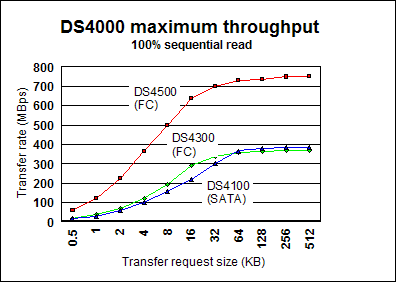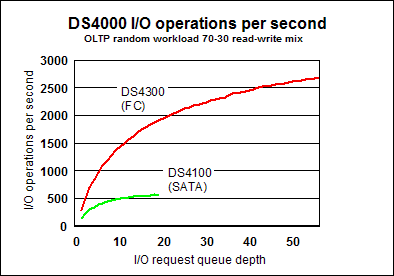Abstract
The IBM TotalStorage DS4000 series of Fibre Channel controllers (formerly known as FAStT) includes devices with Fibre Channel drives and Serial ATA (SATA) drives. The performance characteristics of these two drive types means that customers should evaluate their needs carefully before selecting a controller connected via a Fibre Channel. This technote briefly compares the performance of the DS4100 SATA controller and the DS4300 and DS4500 Fibre Channel controllers.
Main
The DS4100 controller using a SATA drive is suited primarily for sequential I/O operations. In this type of environment, the DS4100 performs very well. Figure 1 illustrates the throughput obtained when performing 100% sequential reads (such as from a video streaming application). Note that the DS4500 (FAStT900) is the best performer for streaming workloads and that the SATA-based DS4100 (FAStT100) is as good if not better than the DS4300 (FAStT600).
The RAID controllers contribute to the significant difference in maximum throughput capability. The DS4500 is a more powerful RAID controller than the DS4300. The similar performance in maximum throughput capability between the DS4100 and the DS4300 is because these RAID controllers are very similar, with the exception that the DS4100 is a storage server that uses a SATA drive while the DS4300 is a storage server that uses a Fibre Channel drive.
Figure 1: DS4000 throughput comparison using 100% sequential read operations
(Configuration: 64 KB segment, Read cache enabled, 16 KB cache block, 8% drive stroke, Dual RAID controllers, RAID-5, 14 drives, DS4300: 15K RPM, DS4100: 7200 RPM)
For random OLTP workloads, however, the DS4300 can handle significantly more I/O requests than the DS4100, as shown in Figure 2.
Figure 2: DS4000 throughput comparison using 70-30 read-write mix
(Configuration: 64 KB segment, Read cache enabled, 16 KB cache block, 8% drive stroke, Dual RAID controllers, RAID-5, 14 drives, DS4300: 15K RPM, DS4100: 7200 RPM)
The data illustrated in Figure 2 substantiates that the D4100 is designed for seldom-accessed, near-line storage. You should not implement this system as part of a storage subsystem that you use to access data frequently, such as file serving, Web serving, database applications, and mail applications. SATA drive technology is currently not robust enough to handle the duty cycles of enterprise class applications.
For more information about SATA, see:
- Introducing IBM TotalStorage FAStT EXP100 with SATA Disks, REDP-3794
- Tuning IBM eServer xSeries Servers for Performance, SG24-5287
This redpaper and redbook are available from: http://ibm.com/redbooks
For more detailed DS4000 performance information, read the following papers written by Charles Stephan of the xSeries Performance Lab:
- Comparison of the Performance of the DS4300 (FAStT600) and FAStT200 Storage Servers
- Comparison of the Performance of the DS4500 (FAStT900) and DS4400 (FAStT700) Storage Servers
These papers are both available in from: http://www.pc.ibm.com/ww/eserver/xseries/benchmarks/related.html
Related product families
Product families related to this document are the following:
Trademarks
Lenovo and the Lenovo logo are trademarks or registered trademarks of Lenovo in the United States, other countries, or both. A current list of Lenovo trademarks is available on the Web at https://www.lenovo.com/us/en/legal/copytrade/.
The following terms are trademarks of Lenovo in the United States, other countries, or both:
Lenovo®
xSeries®
The following terms are trademarks of other companies:
IBM® and ibm.com® are trademarks of IBM in the United States, other countries, or both.
Other company, product, or service names may be trademarks or service marks of others.
